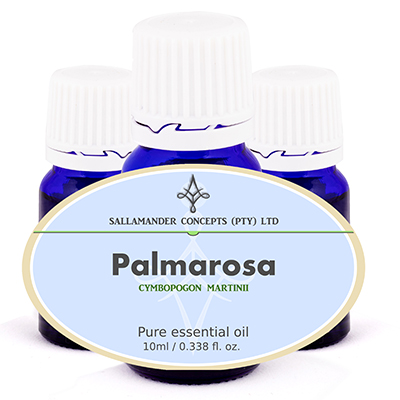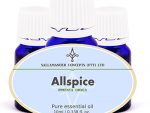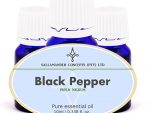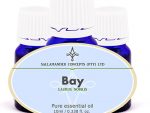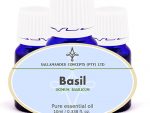Information on Palmarosa Essential Oil
Palmarosa Essential Oil is extracted from Cymbopogon martini (also known as Cymbopogon martinii var. martinii) of the Gramineae family and is also known as East Indian and Turkish geranium, as well as Indian rosha and motia.
Palmarosa Essential Oil is fast becoming a firm favorite in essential oil therapy and aromatherapy, as it has excellent skin care properties and is also used to relieve stiff and sore muscles, while calming the mind and uplifting and invigorating the spirits and clearing muddled thinking.
Oil Properties
Palmarosa Essential Oil has a sweet floral, with a hint of rose and is pale yellow in color with a nearly watery viscosity.
Origin
It is a wild growing, herbaceous green and straw-colored grass, with long slender stems, terminal flowering tops and fragrant grassy leaves.
It is harvested before the flowers appear and the highest yield is obtained when the grass is fully dried – about one week after it has been cut.
There are two varieties of grass from which the oil can be extracted – motia and sofia.
We find the sofia chemotype to be far more active and pleasant smelling – and for this reason the oil sold by us is from this chemotype.
Because palmarosa oil has a rose-like smell, it is often used by unscrupulous essential oil wholesalers and retailers to adulterate rose essential oil.
It is often used as an ingredient of soaps, perfumes and cosmetics, and is also used in the flavoring of tobacco.
Extraction
Palmarosa Essential Oil is extracted from the dried grass harvested before it flowers by steam distillation.
The yield is 1 – 1.5 %.
Chemical composition
Some of the main chemical components of palmarosa oil are Geraniol, Geranyl acetate, (E,Z)-Farnesol, Linalool, (E)-β-Ocimene, β-Caryophyllene, Geranial
Precautions
Palmarosa Essential Oil may theoretically have weak contra indications when used with drugs that are metabolized by CYP2B6 enzymes; such as artemisinin, bupropion, cyclophosphamide, efavirenz, ketamine, and methadone. Otherwise, the oil has GRAS status and is generally regarded as safe. There is also a low risk of skin sensitization reported in a few studies = care should be taken with people who have extra-sensitive skin.
As with most essential oils, this essential oil should be kept in a dark and cool place and should be stored in an airtight glass bottle (Preferably in the fridge at a temperature of around 4° Celsius / 39° Fahrenheit).
Please read our page with heading: Safety with Essential Oils before using this oil.
We recommend the following book as an excellent resource regarding safety:
Essential Oil Safety: A Guide for Health Care Professionals by Robert Tisserand & Rodney Young (#ad).
Therapeutic properties
The therapeutic properties of Palmarosa oil are antiseptic, antiviral, bactericide, cytophylactic, digestive, febrifuge and hydrating.
For our glossary and explanation of these therapeutic terms, please click here
Uses
Palmarosa Essential Oil calms the mind, yet has an uplifting effect, while clearing muddled thinking. It is used to counter physical and nervous exhaustion, stress-related problems and nervousness.
It is most useful during convalescence and cools the body of fever, while aiding the digestive system, helping to clear intestinal infection, digestive atonia and anorexia nervosa.
It is effective in relieving sore, stiff muscles.
Palmarosa oil moisturizes the skin, while balancing the hydration levels and stimulating cell regeneration.
It balances production of sebum, to keep the skin supple and elastic and is valuable for use with acne, dermatitis, preventing scarring, rejuvenating and regenerating the skin, as well as fighting minor skin infections, sore tired feet and athlete’s foot.
Burners and vaporizers
In vapor therapy, palmarosa oil can help during convalescence.
It relieves fatigue, nervousness, exhaustion and stress, while having an uplifting effect on the mind and clearing muddled thoughts.
Blended Massage Oil or in the Bath
In a blended massage oil or diluted in the bath, Palmarosa oil can be used on convalescent patients, to fight exhaustion, fatigue, nervousness, stress, bolstering the digestive system, while boosting the health of the skin.
Wash, Lotions and Creams and used Neat
Palmarosa Essential Oil can help clear up infections and prevent scarring when added to the water used to wash a wound.
When included in creams and lotions, it has a moisturizing and hydrating effect on the skin, which is great to fight wrinkles. It also balances the natural secretion of sebum, which keeps the skin supple and elastic.
On a cellular level, it helps with the formation of new tissue and for that reason is great for rejuvenating and regenerating the skin. It is most useful when fighting a dry skin and to sort out skin infections.
Some people find that they have great results when applying palmarosa oil neat to the affected area of athlete’s foot – but please keep in mind that we do not advocate the use of neat essential oils on the skin.
Suggested Dilution Rates
On the skin
Adult:
Face: 0.5% to 1.5%
Body: 0.5% to 3%
Bath: 0.5% to 4%
3 to 24 months:
Face: 0.25% to 0.5%
Body: 0.25% to 0.5%
Bath: Maximum of 0.5%
2 to 6 years:
Face: 0.5% to 1.5%
Body: 0.5% to 2%
Bath: 0.5% to 2 %
6 to 15 years
Face: 0.5% to 1.5%
Body: 0.5% to 3%
Bath: 0.5% to 3%
Pregnancy
Face: 0.5% to 1.5%
Body: 0.5% to 2%
Bath: 0.5% to 2%
- When in doubt consult your doctor / medical professional before use.
- Most professionals and/or Aromatherapists will always err on the side of safety when giving advice regarding the use of essential oils and oleo resins during pregnancy.
- Quite a number of Aromatherapists advise that you should avoid all essential oils completely while pregnant, specifically during the first trimester. This is a very safe approach but may not be necessary at all.
Diffusers and Vaporisers
4 to 8 drops
General:
- When using for the first time – Always use the lowest dilution rate and build up slowly to the maximum. Stop using all essential oils on the skin if irritation or allergy occurs.
- Any advice or instruction received from a medical professional ALWAYS supersedes recommendations or advice found on this website. When in doubt consult your doctor / medical professional.
Summary
Palmarosa Essential Oil could be used with good effect on the skin, for nervous and stress-related problems and for the digestive system. Palmarosa oil may provoke a negative reaction when used topically on extra-sensitive skin, so a low dilution rate is advised in this instance.
Blends
Although essential oils blend well with one another, Palmarosa oil blends particularly well with Geranium, Bergamot, Rosemary, Lime and Ylang-ylang.

